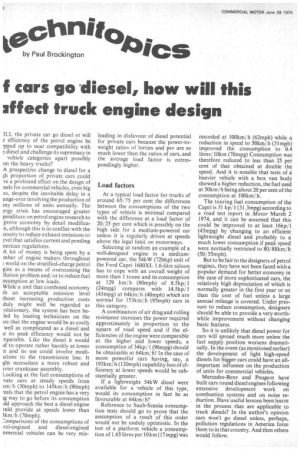f cars go 'diesel, how will this Med truck engine design
Page 50

If you've noticed an error in this article please click here to report it so we can fix it.
ILL the private car go diesel or will e efficiency of the petrol engine be :pped up to near compatibility with e diesel and challenge its supremacy in vehicle categories apart possibly im the heavy trucks?
A prospective change to diesel for a ;h proportion of private cars could ve a profound effect on the design of :sels for commercial vehicles, even big es, despite the inevitable delay in a ange-over involving the production of my millions of units annually. The ergy crisis has encouraged greater penditure on petrol engine research to prove economy by detail modificam, although this is in conflict with the cessity to reduce exhaust emissions to evel that satisfies current and pending nerican regulations.
A lot of money is being spent by a mber of engine makers throughout world on the stratified-charge petrol gine as a means of overcoming the Ilution problem and / or to reduce fuel nsumption at low loads.
While a unit that combined economy th an acceptable emission level thout increasing production costs duly might well be regarded as rolutionary, the system has been beled by leading technicians on the ire that the engine would be as costly well as complicated as a diesel and a its peak• efficiency would not be -nparable. Like the diesel it would id to. operate rather harshly at lower n and its use could involve modiations to the transmission line. It ght necessitate a more robust and ivier crankcase assembly.
Looking at the fuel consumptions of vate cars at steady speeds from :cm/ h (30mph) to 145km/ h (90mph) vals that the petrol engine has a very kg way to go before its consumption aid approach the best a diesel engine )uld provide at speeds lower than lkm/h (70mph). :omparisons of the consumptions of rol-engined and diesel-engined nmercial vehicles can be very mis leading in disfavour of diesel potential for private cars because the power-toweight ratios of lorries and psv are so much lower than the ratios of cars, and the average load factor is. correspondingly higher.
Load factors At a typical load factor for trucks of around 65/75 per cent the differencee between the consumptions of the two types of vehicle is minimal compared with the difference at a load factor of 20/ 25 per cent which is possibly on the high side for a medium-powered car unless it is regularly driven at speeds above the legal limit on motorways.
Selecting at random an example of a well-designed engine in a mediumpowered car, the 54kW (72bhp) unit of the Ford Capri 1600XL 1.6-litre saloon has to cope with an overall weight of more than 1 tonne and its consumption at 129 km/h (80mph) of 8.5kp/ 1 (24mpg) compares with 14.5kp/ 1 (41mpg) at 64km/ h (40mph) which are normal for 153krn/ h (95mph) cars in this category.
A combination of air drag and rolling resistance increases the power required approximately in proportion to the square of road speed and if the efficiencies of the engine were comparable at the higher and lower speeds, a consumption of 34kp/ 1 (96mpg) should be obtainable at 64km/ In the case of more powerful cars having, say, a 193km/ h (120mph) capability loss of efficiency at lower speeds would be substantially greater.
If a lightweight 54kW diesel were available for a vehicle of this type, would its consumption in fact be as favourable at 64km/ h?
Reference to Saab-Scania consumption tests should go to prove that the assumption of a result of this order would not be unduly optimistic. In the test of a platform vehicle a consumption of 1.65 litres per 10 km (17 mpg) was recorded at 100km/ h (62mph) while a reduction in speed to 50km/ h (31mph) improved the consumption to 0.4 litres/ 10km (70mpg) Consumption was therefore reduced to less than 25 per cent of that obtained at double the speed. And it is notable that tests of a heavier vehicle with a box van body showed a higher reduction, the fuel used at 50km/ h being about 20 per cent of the consumption at 100km/h.
The touring fuel consumption of the Capri is 31 kp/ 1 (31.3mpg) according to a road test report in Motor March 2 1974, and it can be assumed that this could be improved to at least 16kp/1 (45mpg) by changing to an efficient lightweight diesel and probably to a much lower consumption if peak speed were normally restricted to 80/ 88km/ h (50/ 55mph).
But to be fair to the designers of petrol engines, they have not been faced with a popular demand for better economy in the case of more sophisticated cars, the relatively high depreciation of which is normally greater in the first year or so than the cost of fuel unless a large annual mileage is covered. Under pressure to reduce consumption, designers should be able to provide a very worthwhile improvement without changing basic features.
So it is unlikely that diesel power for cars will spread much more unless the fuel supply position worsens dramatically. In the event (as mentioned earlier) the development of light high-speed diesels for bigger cars could have an allimportant influence on the production of .units for commercial vehicles.
Mercedes-Benz and Peugeot have built cars round diesel engines following extensive development work on combustion systems and on noise reduction. Have useful lessons been learnt in the process that are applicable to truck diesels? In the author's opinion cars won't go diesel unless, perhaps, pollution regulations in America force them to in that country. And then others would follow.












































































































